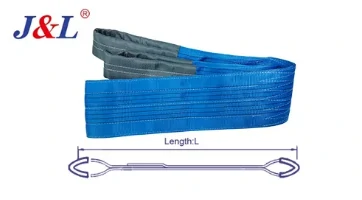Can Webbing Slings Be Used in Oil, Water, and Solvents Without Affecting Capacity?
April 11, 2025
Webbing slings are vital tools in material handling; however, exposure to chemicals such as oil, water, and solvents raises significant concerns regarding safety and loading capacity. According to manufacturer guidelines, this article focuses on how various environments influence webbing sling materials and offers recommendations for how to use.

1. Raw Materials and Chemical Resistance
Web slings are typically fabricated with three primary synthetic fibers:
Polyester (PES):
It is resistant to most inorganic acids but susceptible to strong alkalis.
Polyester webbing lifting slings can be applied to water, oily or UV-exposed environments; besides, it should avoid contact with alkaline solutions (e.g., sodium hydroxide).
Polyamide (PA/Nylon):
Nylon webbing slings are not easily corroded by alkalis but can be washed away by inorganic acids and oxidizing agents. The strength of wet webbing slings can reduce by 10-15% temporarily and then it can be restored by drying.
Polypropylene (PP):
PP slings are of highly anti-acids and anti-alkalis, but should avoid contact with chlorinated solvents like chloroform. PP lifting slings can be used under harsh chemical environments with a lower temperature threshold of 80°C.
2. Effects of Specific Environments
Oil – Polyester and polypropylene slings can be regularly utilized in most oils without damage to the strength; while regular cleaning are requested to remove residue and dirt. Nylon made slings are easily degraded after contact with certain petroleum-based oils so that exercise caution is necessary.
Water – Immersion in saltwater or sewage for a long run can cause irreversible damage to web slings. Ice on the surface may lead to cuts, abrasions, and reduced flexibility. Users are advised not to use web slings in situations with an extreme temperature (below-40°C) and moisture without a proper antifreeze option.
Solvents: PP fiber slings resist acetone and ethanol but soften when exposed to chlorinated solvents such as carbon tetrachloride. Polyester and Nylon fiber slings are subject to degradation in the presence of ketones or aromatic hydrocarbons.
3. Factors Influencing Performance
Polyester and nylon fibers normally work efficiently between -40°C and 100°C and polypropylene from -40°C to 80°C. Increase on temperatures will accelerate risks on the damage to the load capacity; ice may exacerbate physical damage in cold conditions.
Even innocuous diluted acids/alkalis may become corrosive following evaporation and concentration, so that users need pay attention to the chemical environment and consult with the manufacturer for suggestions. Contaminated slings must be promptly retired, soaked in cold water, and assessed for integrity.
4. Recommendations for Safe Use
Slings outfitted with Grade 8 fittings must NOT be utilized in acidic environments to mitigate the risk of hydrogen embrittlement.
Keep verifying chemical compatibility with manufacturers prior to exposing slings to chemical environments.
Inspect for flexibility and surface integrity after using in low-temperature conditions; Avoid exceeding material tolerance limits in high-temperature.
For special application purpose in specific, user need to clarify the using condition with the manufacturer so that special treatment on the surface and material are to be conducted.
5. Conclusion
The capacity of web slings is profoundly influenced by chemical exposure and temperature conditions. Compliance with manufacturer guidelines, appropriate material selection, and regular inspections are pivotal for ensuring safety.
By implementing scientific material selection and rigorous management practices, the longevity of web slings can be maximized, ensuring operational safety at all times.
Research on the development of new materials and new production technology are permanent topic that can improve the applicability for various using conditions.
